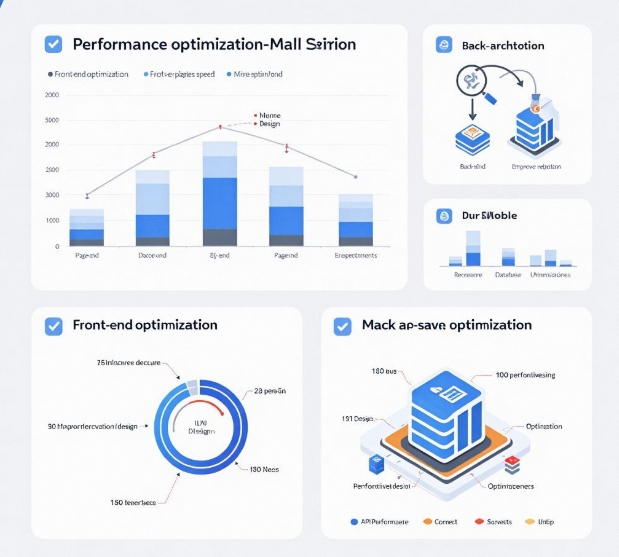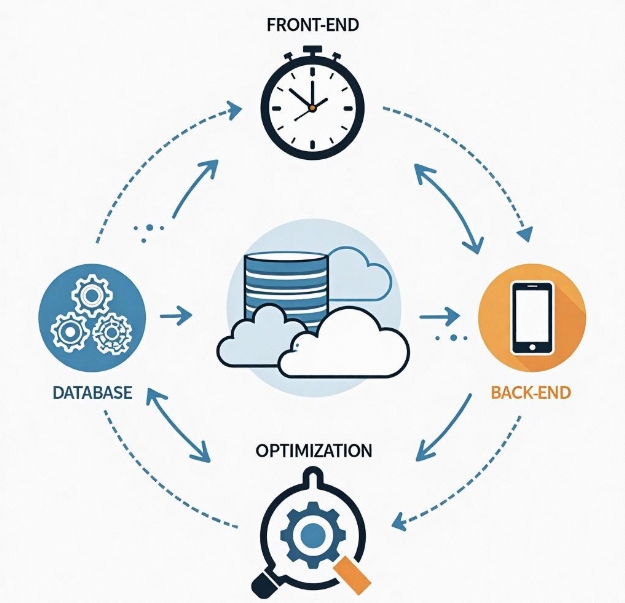Shenzhen Mall App Development Performance Optimization (Loading Speed/Concurrency Handling)
- latest articles
- 1.DApp Development & Customization: Merging Diverse Market Needs with User Experience 2.Analysis of the Core Technical System in DApp Project Development 3.How to achieve cross-chain interoperability in Web3 projects? 4.How does the tokenization of points reconstruct the e-commerce ecosystem? 5.How to Set and Track Data Metrics for a Points Mall? 6.What is DApp Development? Core Concepts and Technical Analysis 7.Inventory of commonly used Web3 development tools and usage tips 8.Development of a Distribution System Integrated with Social E-commerce 9.Six Key Steps for Businesses to Build a Points Mall System 10.What is DApp Development? A Comprehensive Guide from Concept to Implementation
- Popular Articles
- 1.Future Trends and Technology Predictions for APP Development in 2025 2.Analysis of the DeFi Ecosystem: How Developers Can Participate in Decentralized Finance Innovation 3.From Zero to One: How PI Mall Revolutionizes the Traditional E-commerce Model 4.DAPP Development | Best Practices for Professional Customization and Rapid Launch 5.Recommended by the Web3 developer community: the most noteworthy forums and resources 6.From Cloud Computing to Computing Power Leasing: Building a Flexible and Scalable Computing Resource Platform 7.How to Develop a Successful Douyin Mini Program: Technical Architecture and Best Practices 8.Shared Bike System APP: The Convenient Choice in the Era of Smart Travel 9.How to Create a Successful Dating App: From Needs Analysis to User Experience Design 10.From Design to Development: The Complete Process of Bringing an APP Idea to Life
With the advancement of technology, smartphone applications have become an indispensable part of modern life. In the realm of shopping, the rise of shopping mall apps allows consumers to enjoy convenient shopping experiences anytime and anywhere, especially in Shenzhen, a rapidly developing city where the demand for shopping mall apps is increasingly growing. However, a significant issue shopping mall apps face in practical use is performance optimization, particularly in terms of loading speed and concurrent processing. If these performance issues are not resolved promptly, they will directly impact the user experience, thereby affecting user retention and conversion rates for the mall. Therefore, how to enhance the loading speed of shopping mall apps and improve their concurrent processing capabilities has become a technical challenge that developers and product managers urgently need to address.
This article will focus on the performance optimization of Shenzhen shopping mall apps, with a particular emphasis on optimizing loading speed and improving concurrent processing. Through specific technical methods and practical case analyses, it aims to help developers fundamentally enhance the performance of shopping mall apps and optimize the user experience.
I. Optimization of Shopping Mall App Loading Speed
In modern society, users have extremely high demands for app loading speeds. This is especially true for shopping mall apps, which involve critical processes such as product display and payment flows. The loading speed of each step directly affects user satisfaction. To avoid user churn due to slow loading speeds, optimizing the loading speed of shopping mall apps is crucial. Next, we will analyze the optimization strategies for shopping mall app loading speeds in detail from both front-end and back-end perspectives.
1. Front-End Optimization: Reducing Page Rendering Time
Front-end optimization is a key aspect of improving app loading speed, especially during the page rendering process. How to reduce page rendering time and increase page responsiveness has become a critical focus of optimization.
a. Reducing Unnecessary HTTP Requests
During app loading, each HTTP request increases loading time. To optimize loading speed, developers can reduce the number of HTTP requests by merging multiple JS and CSS files. Additionally, using lazy loading for images to load only those within the user's current view can effectively improve page loading speed.
b. Resource Compression and Caching
Compressing static resources such as images, JS, and CSS can significantly reduce file sizes, thereby speeding up loading. At the same time, utilizing browser caching to store static resources on the user's device can reduce redundant loading and further enhance the user experience.
c. Using CDN to Accelerate Resource Distribution
Deploying static resources to a CDN (Content Delivery Network) can speed up resource loading. By selecting CDN nodes closer to the user, file transfer times can be shortened, reducing loading delays.
d. Asynchronous Loading and Lazy Loading of Code
Using asynchronous loading techniques ensures that critical resources in the page (such as product information, payment pages, etc.) are loaded first without affecting user interaction. Meanwhile, employing lazy loading techniques to load other content only when needed avoids loading too much content at once, which can cause page lag.
2. Back-End Optimization: Reducing Server Response Time
The performance of the back-end server also directly affects the loading speed of shopping mall apps. To improve server response speed, developers can optimize from the following aspects:
a. Database Optimization
Shopping mall apps often need to query large amounts of product data from the database. If database query efficiency is low, it will inevitably lead to slow response times. Therefore, optimizing database queries is key to improving loading speed. Developers can optimize SQL queries, use indexes to speed up the query process, and employ strategies like table partitioning and database sharding to avoid single points of bottleneck in the database.
b. Interface Optimization
The design and optimization of back-end interfaces also determine the app's loading speed. Reducing the number and complexity of API interfaces and avoiding long-blocking interface calls can effectively reduce response delays. Additionally, the data returned by interfaces should be as concise as possible, avoiding unnecessary data redundancy to reduce transmission time.
c. Caching Technology
Using caching technology can significantly improve the loading speed of shopping mall apps. For example, employing caching technologies like Redis to store frequently used data (such as popular products, user information, etc.) in memory avoids frequent database access and reduces response delays.
d. Server-Side Load Balancing
When facing a large number of concurrent requests, shopping mall apps often put significant pressure on the server. By using load balancing technology to distribute requests across multiple servers, the system's concurrent processing capacity can be effectively improved, thereby enhancing loading speed.
3. Mobile Performance Optimization
Compared to PC devices, mobile devices have weaker hardware performance. Therefore, when optimizing the performance of shopping mall apps, the hardware limitations of mobile devices are a factor that cannot be overlooked.
a. Optimizing App Startup Speed
During app startup, avoid loading too many resources, reduce the complexity of startup animations, and quickly display the main interface to improve the user's waiting experience.
b. Reducing App Memory Consumption
Excessive memory usage can cause the app to run slowly or crash. Developers can optimize memory management, avoid memory leaks and resource waste, and ensure smooth operation of the app on different devices.
II. Optimization of Shopping Mall App Concurrent Processing
Shopping mall apps often face a large number of concurrent requests during major promotional events or holidays, making the system's concurrent processing capability crucial. To ensure that shopping mall apps can operate smoothly under high concurrency and avoid crashes or excessively long response delays, developers need to implement a series of optimization measures.
1. Concurrent Model Design
When handling a large number of concurrent requests, the first step is to choose an appropriate concurrency model. Common concurrency models include thread pool models, event-driven models, and asynchronous non-blocking models. Selecting the right concurrency model for the shopping mall app can effectively avoid resource contention and improve system throughput.
2. Efficient Task Scheduling
When facing a large number of requests, shopping mall apps often need to schedule requests reasonably. Using technologies such as asynchronous queues and message queues can distribute requests to different processing threads, avoiding resource contention and performance bottlenecks caused by too many threads. At the same time, reasonable task scheduling ensures that high-priority requests are processed first, improving the system's response speed.
3. Database Concurrent Processing
The database is a core component of shopping mall apps, and its performance under high concurrency is particularly important. To improve the database's concurrent processing capability, database connection pool technology can be used to avoid the performance loss caused by frequently creating and destroying database connections. Additionally, employing techniques such as read-write separation and database sharding can effectively increase the database's concurrent throughput.
4. CDN and Distributed Systems
In the case of large-scale concurrent requests, a single server often struggles to handle excessive traffic. By using CDN to accelerate the distribution of static resources and combining it with a distributed system architecture, traffic pressure can be effectively distributed, enhancing the system's concurrent processing capability.
5. Disaster Recovery and Elastic Scaling
When facing high concurrency, shopping mall apps need to have strong disaster recovery capabilities. Adopting disaster recovery design ensures that the system can automatically switch to backup nodes in case of failure, avoiding service interruptions. Furthermore, the elastic scaling capabilities of cloud computing platforms allow shopping mall apps to dynamically adjust server resources based on traffic changes, ensuring stable system operation.
III. Conclusion
The performance optimization of shopping mall apps is a complex and multi-dimensional process involving optimizations on the front-end, back-end, and mobile sides. In terms of loading speed and concurrent processing, adopting reasonable technical measures can effectively enhance the performance of shopping mall apps, optimize the user experience, and reduce churn rates. In the future, with the continuous development of technology, the performance optimization of shopping mall apps will increasingly focus on the application of emerging technologies such as artificial intelligence and big data, providing users with a smoother and more intelligent shopping experience.
-

How does the tokenization of points reconstruct the e-commerce ecosystem?
With the continuous advancement of internet technology and the gradual prolifera···
-

How to Set and Track Data Metrics for a Points Mall?
With the rapid development of the e-commerce industry, points malls, as a common···
-

Development of a Distribution System Integrated with Social E-commerce
With the rapid development of internet technology, the e-commerce industry has e···

 Blockchain
Blockchain












